#杨浚鑫
Explore tagged Tumblr posts
Text
凯伦•陈
殷素素 2024-4-7 在美发展的谐星钱信伊(Ronny…

View On WordPress
0 notes
Text
Analyzing Chinese Names: Syllables & Tones
It’s been a while since my last post about Chinese names. In one previous post, I wrote that I wanted to explore tones and syllable structure in Chinese names. And now here we are. I ended up shifting my focus a bit throughout the process, but I’m still excited to be sharing my results.
These questions/ideas guided this post:
Sometimes you don’t know how a name is written because you’ve only heard it or seen a transliteration. Setting aside the written language (Chinese characters), what syllables/sounds are most common?
I have read about naming conventions regarding tones. For example, using a mix of tones (instead of reusing the same tone) gives names a dynamic flow. So how are tones distributed in names?
Buckle up, everyone. This is gonna be a long one.
About the Data
I started with the data from my previous in-depth post about Chinese names. Like before, most names are from contestants on idol shows or members of idol groups. I added more names in this category and also some names of athletes (since for athletes it is also relatively easy to discern gender). In total, there were 4361 names (2340 female, 2021 male). Most names belong to individuals from Mainland China, but there are also names belonging to people from Taiwan, Hong Kong, Malaysia, and Singapore. See my past post for more details.
I had to do a lot of work to process the name data for this analysis. I will add some details towards the end of this post for those who are interested. I just want to note here that:
I did some work to account for tone sandhi for yi 一. As a result, you may see this character labeled as 1st, 2nd, or 4th tone.
I also applied tone change rules when there were multiple 3rd tones in a row (but not for surnames as it shouldn’t change there).
I had to correct for duoyinzi 多音字. Most of the time, it’s pretty clear which pronunciation is used, but there are some ambiguous cases.
I use standard Mainland pronunciation, not Taiwanese pronunciation. Characters like 薇 are pronounced differently in these locations.
I’m an imperfect human and probably didn’t catch everything. So keep that in mind.
Given Names (Overall)
First we will examine the overall results for all syllables across all given names to get a nice overview. Then we will dive into single-character given names vs. two-character given names.
Top Given Name Syllables (w/ Tones)

Pictured: Some of the most frequent characters for the top 11 syllables.
List format: Syllable / count Corresponding characters that occurred more than once
Yǔ / 263 宇 雨 羽 语 予 禹 瑀
Xīn / 229 欣 鑫 馨 心 昕 新 歆 芯 薪
Jiā / 216 佳 嘉 家 加 珈
Yì / 201 一 艺 奕 逸 亦 毅 懿 翊 义 易 翼 忆 意 译 轶 熠 羿 亿 薏
Zǐ / 139 子 梓 紫
Qí / 134 琪 琦 奇 祺 麒 淇 齐 棋 其 岐 崎
Wén / 116 文 雯 闻 纹
Jié / 112 杰 洁 婕 捷 颉 倢
Yù / 102 玉 钰 煜 昱 郁 裕 喻 谕 毓 育 誉
Jùn / 99 俊 峻 珺 骏 浚 竣
Yáng / 99 洋 阳 扬 杨 炀 旸
Top Given Name Syllables (w/o Tones)
List format: Syllable / count Corresponding characters that occurred more than once
Yu / 419 宇 雨 玉 羽 钰 语 瑜 予 妤 煜 禹 昱 郁 俞 渝 裕 于 喻 瑀 谕 余 娱 愚 毓 育 誉
Yi / 356 一 怡 艺 奕 仪 依 逸 亦 伊 毅 宜 懿 翊 义 祎 易 翼 苡 忆 意 译 轶 颐 乙 以 熠 羿 亿 倚 薏
Xin / 232 欣 鑫 馨 心 昕 新 歆 芯 薪 信
Jia / 217 佳 嘉 家 加 珈
Jun / 165 俊 君 峻 钧 军 珺 均 骏 浚 竣
Zi / 157 子 梓 紫 姿 兹
Qi / 151 琪 琦 奇 祺 绮 麒 启 淇 齐 棋 其 岐 崎
Hao / 141 豪 浩 昊 皓 灏 淏 濠
Wei / 139 伟 玮 威 维 薇 蔚 微 炜 唯 纬 葳 为 崴 巍 𬀩 苇 韦
Xiao / 136 晓 小 笑 筱 孝 潇 篠 箫 肖
Given Name Syllable Tones

List format: Tone / count
2nd / 2729
1st / 1993
4th / 1885
3rd / 1167
Single-Character Given Names (单名)
There were 948 single-character names in total. That comes out to about 22% of all 4361 names.
Top Single-Character Given Names (w/ Tones)
List format: Syllable / count All corresponding characters
Xīn / 41 鑫 欣 昕 馨 新 心 锌
Yáng / 29 洋 扬 杨 阳 旸 炀
Yǔ / 20 宇 雨 禹 羽 瑀 语
Lì / 18 丽 立 莉 俐 栎 栗
Yì / 18 艺 奕 逸 忆 易 毅 燚 羿
Yuè / 18 悦 玥 越 月 粤 跃
Jié / 17 洁 杰 倢 婕 捷 颉
Hào / 16 浩 昊 淏 灏
Jìng / 14 静 婧 靓* 竞 靖
Qiàn / 14 倩 茜**
*Can be pronounced jìng or liàng. I went with jìng. **Can be pronounced qiàn or xī. I went with qiàn.
Top Single-Character Given Names (w/o Tones)
List format: Syllable / count All corresponding characters
Xin / 41 鑫 欣 昕 馨 新 心 锌
Yu / 31 宇 雨 钰 煜 玉 瑜 禹 羽 昱 渝 瑀 语
Yang / 29 洋 扬 杨 阳 旸 炀
Yi / 23 艺 奕 怡 逸 一 忆 易 毅 燚 祎 羿
Wei / 22 伟 威 炜 维 蔚 薇 𬀩 玮
Hao / 19 浩 昊 豪 淏 灏
Jing / 19 静 晶 婧 靓* 璟 竞 菁 靖
Li / 19 丽 立 莉 俐 李 栎 栗
Ying / 19 颖 莹 影 滢 赢 瀛 盈
Yue / 18 悦 玥 越 月 粤 跃
*Can be pronounced jìng or liàng. I went with jìng.
Single-Character Name Tones
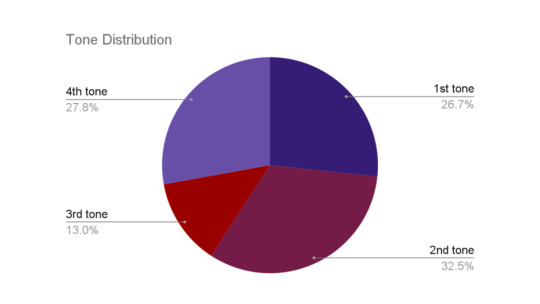
List format: Tone / count
2nd / 308
4th / 264
1st / 253
3rd / 123
Full Name Tone Patterns for Single-Character Given Names

Look at the darker “stripes” for the 2nd tone. The 3rd tone’s low popularity also stood out to me.
List format: Tone of surname, tone of given name / count
2nd, 2nd / 140
2nd, 1st / 127
2nd, 4th / 123
1st, 2nd / 80
1st, 4th / 73
1st, 1st / 68
2nd, 3rd / 52
4th, 2nd / 45
3rd, 2nd / 43
1st, 3rd / 39
3rd, 4th / 37
4th, 4th / 31
3rd, 1st / 29
4th, 1st / 29
4th, 3rd / 17
3rd, 3rd / 15
Two-Character Given Names (双名)
Now for two-character given names. There were 3413 total (about 78%). First I will look at these given names as a whole. Then I will separately examine the 1st syllable and 2nd syllable positions.
I was very interested to see the most common name going by sound and not characters. Living in the US, I often see transliterated Chinese names with no characters in sight. This effectively “merges” names that are distinct in Chinese. All I can do is guess what the characters (and thus tones) are.
Top Two-Character Given Names (w/ Tones)
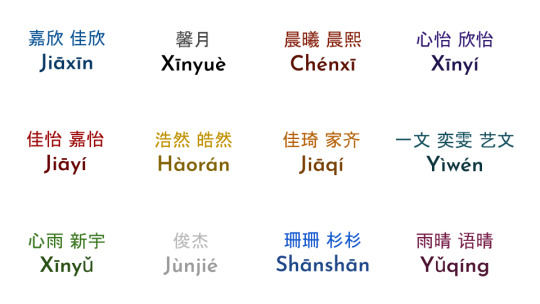
Pictured: Character combinations that occurred more than once for the top 12 two-character given names.
List format: Given name / count All corresponding character combinations
Jiāxīn / 17 嘉欣 佳欣 佳薪 佳鑫 嘉新 嘉歆 嘉馨
Jiāyí / 12 佳怡 嘉怡 佳仪 嘉仪 家仪 家怡
Xīnyǔ / 10 心雨 新宇 心语 欣宇 欣雨 鑫宇 馨予
Xīnyuè / 10 馨月 心玥 昕玥 欣悦 歆玥 馨悦 馨玥
Hàorán / 9 浩然 皓然
Jùnjié / 9 俊杰 俊洁
Chénxī / 8 晨曦 晨熙 晨晞 晨晰 晨溪
Jiāqí / 8 佳琦 家齐 佳琪 嘉琪 嘉祺 嘉齐
Shānshān / 8 珊珊 杉杉 姗姗
Xīnyí / 8 心怡 欣怡 心仪 鑫怡
Yìwén / 8 一文 奕雯 艺文 译文 逸文
Yǔqíng / 8 雨晴 语晴 宇晴 雨情
Top Two-Character Given Names (w/o Tones)
List format: Given name / count All corresponding character combinations
Jiaxin / 17 嘉欣 佳欣 佳薪 佳鑫 嘉新 嘉歆 嘉馨
Jiayi / 16 佳怡 嘉怡 佳仪 佳依 加一 嘉仪 嘉艺 嘉谊 家仪 家怡 家毅
Xinyu / 15 心雨 欣妤 新宇 心妤 心玉 心语 欣宇 欣雨 鑫宇 馨予
Junjie / 12 俊杰 军杰 俊洁 钧杰
Xiaoyu / 12 小雨 晓玉 晓钰 小钰 晓宇 晓瑜 晓雨 笑语
Yifan / 12 一凡 艺凡 一帆 一幡 一璠 依凡 屹繁 怡凡 薏帆
Xinyi / 10 心怡 欣怡 心仪 欣佚 鑫一 鑫怡
Xinyue / 10 馨月 心玥 昕玥 欣悦 歆玥 馨悦 馨玥
Yuqing / 10 雨晴 语晴 宇庆 宇晴 钰清 雨情
Two-Character Given Name Tones
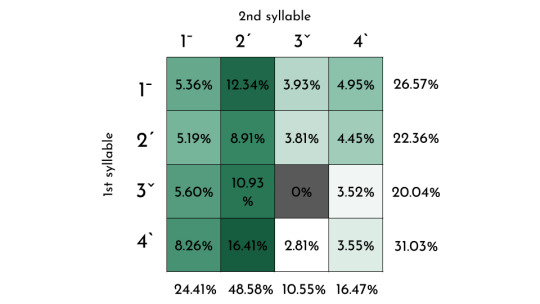
The grey square is due to the 3rd tone tone change rule.
List format: Tone of given name 1st syllable, tone of given name 2nd syllable / count
4th, 2nd / 560
1st, 2nd / 421
3rd, 2nd / 373
2nd, 2nd / 304
4th, 1st / 282
3rd, 1st / 191
1st, 1st / 183
2nd, 1st / 177
1st, 4th / 169
2nd, 4th / 152
1st, 3rd / 134
2nd, 3rd / 130
4th, 4th / 121
3rd, 4th / 120
4th, 3rd / 96
Full Name Tone Patterns for Two-Character Given Names

Pictured: The top 10 full name tone patterns for two-character given names.
I found these results very interesting. As I mentioned earlier, I’ve read about how using certain sequences of tones creates a pleasant-sounding flow. I had some fun saying aloud names that fit these patterns and judging the dynamic ups-and-downs of how they flow.
List format: Tone of surname, tone of given name 1st syllable, tone of given name 2nd syllable / count
2nd, 4th, 2nd / 273
2nd, 1st, 2nd / 179
2nd, 3rd, 2nd / 179
2nd, 4th, 1st / 138
1st, 4th, 2nd / 135
2nd, 2nd, 2nd / 129
1st, 3rd, 2nd / 98
2nd, 3rd, 1st / 95
2nd, 1st, 4th / 92
1st, 1st, 2nd / 89
These are only the top 10 patterns. See the bottom of the post for the full list.
Two-Character Given Names: First Syllable
Top First Syllables for Two-Character Given Names (w/ Tones)
List format: Syllable / count Corresponding characters that occurred more than once
Jiā / 171 佳 嘉 家 加 珈
Yì / 138 一 艺 奕 逸 亦 翊 易 义 懿 翼 译 亿 忆 毅 羿 薏 轶
Zǐ / 123 子 梓 紫
Yǔ / 115 雨 宇 语 羽 禹 予
Xīn / 95 欣 心 馨 鑫 新 昕 歆 薪 芯
Xiǎo / 79 晓 小 筱
Jùn / 69 俊 峻 珺 竣 骏
Sī / 63 思 斯
Yù / 53 玉 钰 煜 昱 郁 裕 喻 毓 育 誉
Mèng / 49 梦 孟
Top First Syllables for Two-Character Given Names (w/o Tones)
List format: Syllable / count Corresponding characters that occurred more than once
Yi / 201 一 艺 奕 怡 依 逸 亦 翊 伊 宜 易 苡 义 乙 以 懿 翼 译 亿 忆 毅 祎 羿 薏 轶
Yu / 188 雨 宇 语 玉 钰 羽 禹 煜 俞 昱 郁 于 渝 裕 予 喻 毓 瑜 育 誉
Jia / 171 佳 嘉 家 加 珈
Zi / 133 子 梓 紫 姿
Xiao / 118 晓 小 笑 孝 潇 筱
Xin / 98 欣 心 馨 鑫 新 昕 歆 信 薪 芯
Jun / 84 俊 峻 君 钧 军 珺 竣 骏
Jing / 67 静 婧 景 敬 靖 晶 京 竞
Zhi / 61 智 志 芷 之 治 知 祉
Si / 60 思 斯
First Syllable Tones for Two-Character Given Names
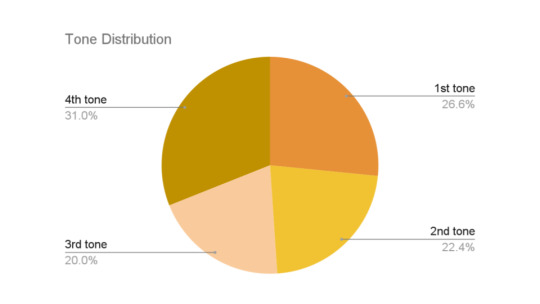
List format: Tone / count
4th / 1059
1st / 907
2nd / 763
3rd / 684
Two-Character Given Names: Second Syllable
Top Second Syllables for Two-Character Given Names (w/ Tones)
List format: Syllable / count Corresponding characters that occurred more than once
Yǔ / 128 宇 雨 羽 予 语 瑀 禹
Qí / 100 琪 琦 祺 奇 淇 齐 棋 麒 岐
Xīn / 93 欣 鑫 馨 昕 心 新 歆 芯
Jié / 83 杰 洁 婕 捷
Wén / 68 文 雯
Yí / 63 怡 仪 宜 颐
Lín / 61 霖 琳 林 麟 淋
Tíng / 61 婷 廷 庭
Yuán / 59 源 元 媛 圆 园 缘 原
Yáng / 58 阳 洋 扬 杨 炀
Top Second Syllables for Two-Character Given Names (w/o Tones)
List format: Syllable / count Corresponding characters that occurred more than once
Yu / 200 宇 雨 玉 羽 瑜 妤 予 钰 语 昱 煜 谕 郁 余 瑀 禹
Yi / 132 怡 仪 一 毅 依 艺 逸 亦 伊 宜 懿 颐 义 奕 意 祎 熠 翼 轶
Qi / 105 琪 琦 祺 奇 淇 绮 齐 棋 麒 岐
Xin / 93 欣 鑫 馨 昕 心 新 歆 芯
Jie / 83 杰 洁 婕 捷
Wei / 75 伟 玮 薇 维 威 微 炜 蔚 葳 崴 纬
Hao / 74 豪 昊 浩 皓 濠
Jun / 72 君 俊 钧 峻 军 均 珺 骏
Wen / 68 文 雯
Yuan / 68 源 元 媛 圆 远 园 渊 缘 原
Second Syllable Tones for Two-Character Given Names

List format: Tone / count
2nd / 1658
1st / 833
4th / 562
3rd / 360
Surnames
Because the majority of the population shares a relatively small number of surnames, I decided to only look at tones.
Surname Tones
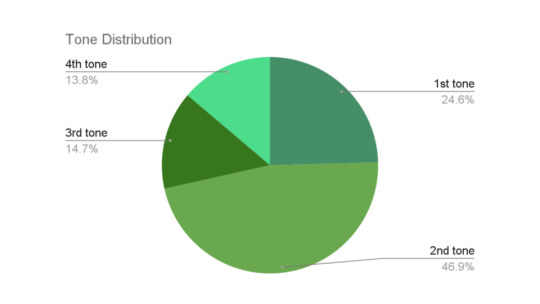
List format: Tone / count
2nd / 2047
1st / 1072
3rd / 640
4th / 602
Just take a look at the top 20 surnames in China. Clearly, the 2nd tone is dominating. There’s only one 4th tone surname!

Data Processing
I segmented the names so each character was alone. I just did this in Google Sheets, because that’s where I store the names I’ve gathered. Then I exported the data in CSV format.
I discarded names longer than 3 characters—because these are less common, I decided not to address them to make things easier for myself.
I used the pinyin library for Python to obtain pinyin for each character. I used the numerical format (ie. “ni3���) so that I could easily obtain the syllable w/o tone, the syllable w/ tone, and the tone. I also utilized pandas and numpy. This was done in Google Colabs. I made the unfortunate mistake of not commenting my code, and I wrote it a while ago, so I now I have no idea what is going on (whoops).
Next I dumped this data into a tibble in R for the real analysis.
For as many 多音字 as I could identify, I had to check and potentially fix the pinyin transcription. For example, I had to make sure that 曾 was going to zeng1, not ceng2. Honestly, I’m sure I missed something, but this was so, so tedious. This is also the step where I accounted for the 3rd tone tone change and yi 一 tone change rules.
I used a Python script to convert the toneless pinyin to my own syllable notation system. This was tricky to figure out, but fortunately I was able to use some code I already had from a project I was involved in during college.
I added the syllable info to my giant tibble in R. Because everything was separated into surname, given name 1st character, and given name 2nd character, I also had to create some new columns to combine information to get information for whole given names and full names.
Then it was basically a lot of pipes. Here’s an example: names %>% filter(nchar(names$name) > 2) %>% group_by(given_struc) %>% summarise(count = n()) %>% arrange(desc(count)) %>% view()
Bonus Lists
There were some other things I was curious about but felt didn’t have a place in the main body of this post.
I wanted to see which syllables were represented by the most unique characters in my dataset. If the number of unique characters is high, that’s a sign that I would probably have trouble guessing which character someone’s name contains.
I was also curious about open vs. closed syllables and closed syllables ending in /n/ vs. /ŋ/. For instance, take a pair of names like Yixin and Xinyi or Xinling and Lingxin. These names consist of the same syllables in a different order. I wanted to know which order is more common.
Syllables with the Most Unique Characters (w/ Tones)
List format: Syllable / count All corresponding characters
Yì / 27 一 艺 奕 逸 亦 毅 懿 翊 义 易 翼 忆 意 译 轶 熠 羿 亿 薏 佚 佾 埸 屹 异 弋 怿 燚 翌
Qí / 15 琪 琦 奇 祺 麒 淇 齐 棋 其 岐 崎 圻 祁 祈 骐
Yú / 14 瑜 妤 俞 渝 于 余 娱 愚 宇*** 愉 榆 舆 雨*** 鱼
Yù / 14 玉 钰 煜 昱 郁 裕 喻 谕 毓 育 誉 寓 浴 芋
Xīn / 12 欣 鑫 馨 心 昕 新 歆 芯 薪 妡 忻 锌
Yuán / 12 源 媛 元 园 圆 缘 原 嫄 沅 湲 芫 袁
Líng / 11 玲 灵 凌 翎 绫 伶 羚 铃 龄 苓 陵
Xī / 11 希 熙 曦 溪 晞 惜 熹 兮 ��� 晰 西
Hóng / 9 宏 红 弘 鸿 泓 虹 洪 闳 汯
Lì / 9 丽 莉 立 力 俐 利 俪 栎 栗
Zhēn / 9 珍 真 臻 蓁 祯 桢 榛 甄 贞
***3rd tone character that is pronounced as 2nd tone due to appearing before another 3rd tone character.
Syllables with the Most Unique Characters (w/o Tones)
List format: Syllable / count All corresponding characters
Yi / 45 一 怡 艺 奕 仪 依 逸 亦 伊 毅 宜 懿 翊 义 祎 易 翼 苡 忆 意 译 轶 颐 乙 以 熠 羿 亿 倚 薏 佚 佾 埸 壹 夷 屹 异 弋 怿 沂 洢 燚 翌 谊 铱
Yu / 33 宇 雨 玉 羽 钰 语 瑜 予 妤 煜 禹 昱 郁 俞 渝 裕 于 喻 瑀 谕 余 娱 愚 毓 育 誉 寓 愉 榆 浴 舆 芋 鱼
Qi / 20 琪 琦 奇 祺 绮 麒 启 淇 齐 棋 其 岐 崎 圻 期 柒 栖 祁 祈 骐
Wei / 20 伟 玮 威 维 薇 蔚 微 炜 唯 纬 葳 为 崴 巍 𬀩 苇 韦 卫 惟 未
Yan / 19 妍 言 燕 彦 艳 岩 延 谚 嫣 琰 雁 晏 研 颜 砚 衍 严 炎 焱
Yuan / 16 源 媛 元 远 园 圆 渊 缘 原 嫄 愿 沅 湲 芫 苑 袁
Xi / 16 希 熙 曦 汐 溪 晞 玺 喜 惜 熹 兮 浠 习 晰 禧 西
Xiao / 15 小 笑 筱 孝 潇 篠 箫 肖 宵 效 枭 校 萧 霄
Yun / 15 云 芸 韵 昀 赟 允 匀 沄 筠 韫 妘 澐 蕰 蕴 运
Zhen / 15 振 珍 真 臻 蓁 祯 震 镇 朕 桢 榛 甄 贞 轸 圳
Two-Character Given Name Syllable Structures
This is the top 10 out of 14 (the bottom 4 were very rare).
List format: Structure of given name 1st syllable, structure of given name 2nd syllable — example / count
Open, open — ex: Jiayi / 821
Open, closed-n — ex: Yijin / 701
Open, closed-ng — ex: Yijing / 468
Closed-n, open — ex: Jinyi / 450
Closed-ng, open — ex: Jingyi / 308
Closed-n, closed-n — ex: Jinyan / 206
Closed-ng, closed-n — ex: Jingyan / 157
Closed-n, closed-ng — ex: Jinyang / 141
Closed-ng, closed-ng — ex: Jingyang / 139
Open, closed-er — ex: Xue'er / 14
Full Name Syllable Structures for Two-Character Given Names
This is the top 29 out of 36 (the bottom 7 were very rare).
List format: Structure of surname syllable, structure of given name 1st syllable, structure of given name 2nd syllable — example / count
Open, open, open— ex: Li Jiayi / 370
Open, open, closed-n— ex: Li Yijin / 336
Closed-ng, open, open— ex: Wang Jiayi / 273
Open, open, closed-ng— ex: Li Yijing / 228
Open, closed-n, open— ex: Li Jinyi / 225
Closed-ng, open, closed-n— ex: Wang Yijin / 223
Closed-n, open, open— ex: Chen Jiayi / 178
Closed-ng, closed-n, open— ex: Wang Jinyi / 165
Open, closed-ng, open— ex: Li Jingyi / 151
Closed-ng, open, closed-ng— ex: Wang Yijing / 146
Closed-n, open, closed-n— ex: Chen Yijin / 142
Open, closed-n, closed-n— ex: Li Jinyan / 104
Closed-ng, closed-ng, open— ex: Wang Jingyi / 97
Closed-n, open, closed-ng— ex: Chen Yijing / 94
Open, closed-ng, closed-n— ex: Li Jingyan / 86
Open, closed-ng, closed-ng— ex: Li Jingyang / 75
Open, closed-n, closed-ng— ex: Li Jinyang / 66
Closed-ng, closed-n, closed-n— ex: Wang Jinyan / 62
Closed-n, closed-n, open— ex: Chen Jinyi / 60
Closed-n, closed-ng, open— ex: Chen Jingyi / 60
Closed-ng, closed-n, closed-ng— ex: Wang Jinyang / 45
Closed-ng, closed-ng, closed-ng— ex: Wang Jingyang / 45
Closed-ng, closed-ng, closed-n— ex: Wang Jingyan / 43
Closed-n, closed-n, closed-n— ex: Chen Jinyan / 40
Closed-n, closed-n, closed-ng— ex: Chen Jinyang / 30
Closed-n, closed-ng, closed-n— ex: Chen Jingyan / 28
Closed-n, closed-ng, closed-ng— ex: Chen Jingyang / 19
Open, open, closed-er— ex: Li Xue'er / 8
Closed-ng, open, closed-er— ex: Wang Xue'er / 4
Extended List(s)
Full Name Tone Patterns for Two-Character Given Names
2nd, 4th, 2nd / 273
2nd, 1st, 2nd / 179
2nd, 3rd, 2nd / 179
2nd, 4th, 1st / 138
1st, 4th, 2nd / 135
2nd, 2nd, 2nd / 129
1st, 3rd, 2nd / 98
2nd, 3rd, 1st / 95
2nd, 1st, 4th / 92
1st, 1st, 2nd / 89
2nd, 1st, 1st / 88
2nd, 2nd, 1st / 84
3rd, 1st, 2nd / 83
3rd, 4th, 2nd / 81
1st, 2nd, 2nd / 73
4th, 4th, 2nd / 71
4th, 1st, 2nd / 70
1st, 4th, 1st / 69
2nd, 3rd, 4th / 68
2nd, 2nd, 3rd / 64
2nd, 1st, 3rd / 59
3rd, 2nd, 2nd / 59
2nd, 2nd, 4th / 56
4th, 3rd, 2nd / 56
2nd, 4th, 4th / 54
2nd, 4th, 3rd / 47
1st, 2nd, 4th / 43
4th, 2nd, 2nd / 43
1st, 1st, 3rd / 42
4th, 4th, 1st / 42
1st, 3rd, 1st / 41
3rd, 3rd, 2nd / 40
1st, 1st, 1st / 35
1st, 2nd, 1st / 35
1st, 2nd, 3rd / 35
1st, 1st, 4th / 34
4th, 1st, 1st / 34
3rd, 4th, 1st / 33
1st, 4th, 4th / 31
3rd, 2nd, 1st / 30
1st, 3rd, 4th / 29
4th, 2nd, 1st / 28
4th, 3rd, 1st / 28
3rd, 2nd, 4th / 27
3rd, 3rd, 1st / 27
3rd, 1st, 1st / 26
4th, 2nd, 4th / 26
1st, 4th, 3rd / 23
3rd, 1st, 4th / 23
3rd, 2nd, 3rd / 21
3rd, 4th, 4th / 20
4th, 1st, 4th / 20
4th, 1st, 3rd / 19
3rd, 4th, 3rd / 18
4th, 4th, 4th / 16
3rd, 1st, 3rd / 14
3rd, 3rd, 4th / 14
4th, 2nd, 3rd / 10
4th, 3rd, 4th / 9
4th, 4th, 3rd / 8
If you made it to the end, I am seriously impressed by your dedication. Thanks for checking out my nerdy ramblings about Chinese names! Don’t forget to check out my past posts on this topic for more. I hope they will help demystify Chinese names and make learning about Chinese names less intimidating.
A Closer Look at Chinese Names
Reading Chinese Names: Female Names
Reading Chinese Names: Male Names
#chinese name#chinese names#chinese#mandarin#mandarin chinese#chinese language#chinese langblr#chinese studyblr#mandarin langblr#mandarin studyblr#language learning#language stuff#learning languages#language study#langblr#studyblr#languages#languageblr#polyglot#foreign languages#study chinese#learn chinese#study mandarin#learn mandarin#studying mandarin#learning mandarin#studying chinese#learning chinese#language blog
333 notes
·
View notes
Text
跳脱二元思维看以巴
殷素素 沈泽玮的《超越二元思维看以巴》并没有告诉我们什么方法,只是塞进私货,从侧面告诉我们人民行动党政府的“一贯正确”: 支持以色列拥有捍卫免受袭击的自卫权,不等于赞同以色列无视国际法、无差别地杀害平民。谴责哈马斯向以色列发动恐怖袭击,不等于无视巴勒斯坦平民面对的人道危机。批评以色列扶持哈马斯牵制巴解,不等于漠视巴勒斯坦领导层内部的分裂与腐败。谴责以色列在约旦河西岸被占领的巴勒斯坦领土上修建犹太人定居点,无碍于向受伤害的以色列民众表示关怀。死在哈马斯枪下的以色列人,跟被以色列炮弹击中的巴勒斯坦人一样,都是人。 她没告诉我们,这些“不等于”是怎么产生的,难道是唯心论?行动党政府是美国的马仔,在“战事”刚开始的时候,第一时���就站在以色列那边,谴责哈马斯的暴行,定义为恐怖主义,强调以色列有自卫的权力。过后可能感受到情势的微妙变化,才用“唯心论”来自圆其说。 11月07日杨浚鑫的《国会观察:外交…
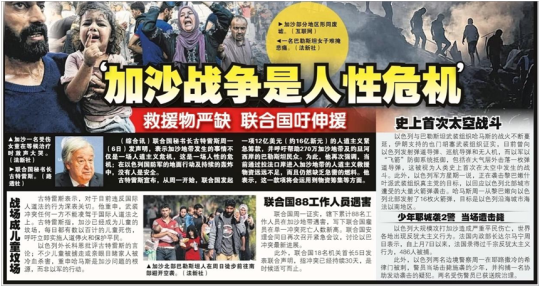
View On WordPress
0 notes
Text
卖身求荣
殷素素 …

View On WordPress
0 notes
Text
失之东隅 收之桑榆
李莫愁 2022-11-8 建屋局涉嫌“卖乖”,年年财报都是赤字,上一个财年更创下一个最高43亿元的亏损,敢情是改朝换代要来了,为博取国人对行动党政府的感恩之情,正如老吴(老番癫吴俊刚,下同)所说的,其实是一项政治决定: 政府把国有土地拿出来建组屋,把房子卖给人民,在计算地价时,是应该按市价还是按当年的征用价?这其实已超越了经济学的争论,而是近乎政治的争论了。这类似政府每年应动用多少国家储备金净投资回报,最终是个政策决定。 所谓“赤字”,很快就被有识之士“看破手脚”: 1、《联合早报》:暗指新加坡政府从宏茂桥预购组屋项目中获利,杨南强和“网络公民”接到(泼马)更正指示。/国家发展部星期五(10月14日)发文告说,新加坡政府投资公司(GIC)前首席经济师杨南强于10月4日在脸书(前译“面簿”)的贴文,及“网络公民”(The Online…

View On WordPress
0 notes
Text
幸灾乐祸2
韦春花 …

View On WordPress
0 notes
Text
纯真年代
韦春花 …

View On WordPress
0 notes
Text
危机公关和大内宣
殷素素 …

View On WordPress
0 notes
Text
歹心做坏事
韦春花 2019-2-26
明明是歹人心机深,党报四��又何必枉作丑人,以讹传讹来离间收入族群呢?
《红蚂蚁》甫出世就自诩“咬人很痛”,也确实有过那么一小段日子。近来大概“上面”的压力太大,渐渐就兑变成标题党;题目确实起得很耸动,料就那么一点点而已。
看沈泽玮用“好心做坏事”好像好几回了,关键词当然就是“好心”,而具“好心”的当然是“好人”咯。
党报四妞好像很努力塑造一种既定看法:她们之所以不平则鸣,主要是替底层的人民不值,因为政府的“好心”,“便宜”都让高收入的占了(很社会主义):
韩咏梅说:在准备过退休生活的亲友,关心的是自己的钱什么时候提取最好;经济能力较强的人,乐得把CPF当成自己其他投资和储蓄的另一个退休保障。
杨浚鑫说:年满70岁仍未领取每月入息的人士,大多来自高收入群体,其储蓄已足够应付退休生活。有部分人士因此选择将钱继续存放在退休户头中,以赚取每年高达6%的利息,待…
View On WordPress
0 notes
Text
Opt in or out?
Opt in or out?
韦春花 2019-2-10
公共服务领域要收集反馈,可以利用opt in(选择加入)或者opt out(选择退出)两种手段。“选择加入”尊重反馈者的自主意见;而“选择退出”则是甲方要强加主意在乙方身上,利用人们安于现状的物理惰性或者无知,来取得mandate(授权)。
《联合早报》狗腿小妮杨浚鑫说:“虽然公积金局的这封信,不仅假定收信人已理解政策细节,并且没有配上华文、马来文及淡米尔文的翻译,在英文的表述上也有欠妥当。信中写道:‘如果您希望在70岁时开始领取每月入息,则无需采取任何行动’。这使人误以为,领取每月入息已改为‘选择退出’(opt-out)…
View On WordPress
0 notes
Text
诡辩
韦春花 2019-2-24
读“停一停大婶”的洪奕婷这篇《政府说不出的话》,有种莫名的兴奋,因为几乎每一段都可以写一篇文章来反驳。想不到继韩咏梅和杨浚鑫之后,她也愿意来掺一脚。
读这种二丑的“持平”文章,好像也说得蛮有道理,如果你不考虑以下的因素:
1、根据一项2016年的调查,国人的预期寿命为82.80岁。从65开始领取公积金入息的话,大概18年后就挂掉了;70岁开始的话,则更短。而公积金则硬性规定要28年才能领完,杨莉明还说什么政府无利可图!?
2、查理布朗对史努比说:“有一天我们全都会死掉。”史努比回应说:“是的,但所有其他的日子我们还活着。”——而活着天天都需要用到钱,提前死了,则公积金局“赚到”。
3、如果把杨莉明也算作4G领袖的话,面对来临的大选,4G都要把自己塑造成愿意聆听,且具同理心,很接地气的新一代领袖。然而,客家妹子在解释公积金入息领取年龄的争议上,则是采用…
View On WordPress
0 notes